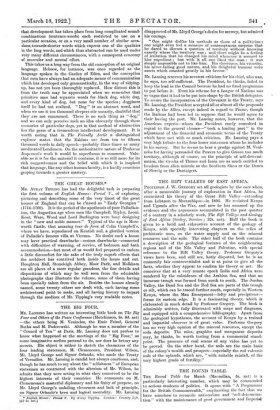THE Rirr VALLEYS OF EAST AFRICA.
PROFESSOR J. W. GREGORY set all geologists by the ears when, after a memorable journey of exploration in East Africa, he enunciated his theory of the Great Rift Valley—extending from Lebanon to Mozambique—in 1896. He revisited Kenya and Uganda after the War, and now he has summed up the evidence and the arguments accumulated in the past quarter of a century in a scholarly work, The Rtft Valleys and Veology of East Africa (Seeley, Service ; 32s. net). Half the book is given to a lucid and exhaustive account of the geology of Kenya, with specially interesting chapters on the relics of prehistoric man, on the water supply and on the mineral resources and the soils. The other half of the book contains a description of the geological features of the neighbouring regions and of the Nile Valley and Palestine, with special reference to the Rift Valley theory. Professor Gregory's views have been, and still are, hotly disputed, but he is an eminently fair controversialist and is at pains to give all the facts, whether they appear to confirm his theory or not. He conceives that at a very remote epoch India and Africa were sundered by the subsidence of the Arabian Sea, and that an immense trough was formed from north to south. The Jordan Valley, the Dead Sea and the Red Sea are parts of this trough or rift, which can be traced further south, especially in Western Kenya, where the Mau Escarpment—lofty and precipitous— forms its eastern edge. It is a fascinating theory, which is elaborated in much detail by Professor Gregory. The book is admirably written, fully illustrated with maps and diagrams, and equipped with a comprehensive bibliography. Apart from the geological hypotheses, the account of Kenya by a trained and impartial observer is of great value. Professor Gregory has no very high opinion of the mineral resources, except the soda deposits. The mica, graphite and manganese deposits may, he thinks, be worth testing from a commercial stand- point. The presence of coal Minas of any value has yet to be proved. On the other hand, the soils are the main basis of the colony's wealth and prospect—especially the red volcanic soils of the uplands, which are, "with suitable rainfall, of the very highest grade of fertility."


































 Previous page
Previous page